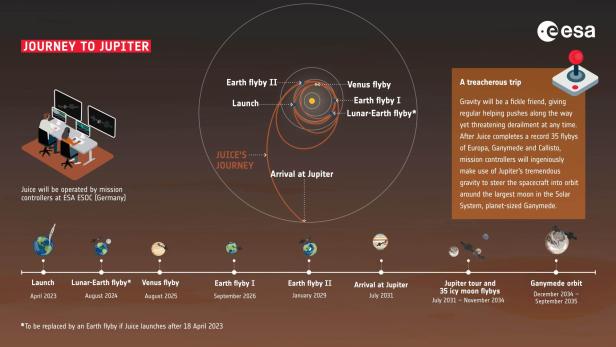The montage shows JUICE in front of Jupiter, Ganymede (top left), Callisto (bottom left) and Europa (right)
© ESA/ATG medialab/NASA/JPL-Caltech/DLR/SwRI/MSSS/G.Eichstadt/S.Doran
Franziska Bechtold
Finding of Life outside the earth is one of the great goals of space travel. With the hope of discovering clues, the European space agency starts ESA today their mission to the Ice moons of Jupiter. The space probe JUICE (Yespeter Icy Moons Explorer) is under the dense ice surfaces of Ganymede, Europa and Callisto look.
The mission is designed to answer many unanswered questions about the Jovian system. It is known that the moons of a ice crust are covered. They are so far from the sun that temperatures there -130 bis -220 Grad to rule. JUICE is to investigate whether, as is generally assumed, deep oceans of liquid water are hidden beneath them.
magnetic field and atmospheres
A special focus is on the largest of the moons, Ganymede. It is almost half the size of Earth and is the only moon in the solar system to have a own magnetic field with 2 poles. Among other things, it is being investigated what effects it has on the surface composition and how it interacts with Jupiter’s magnetic field.
Europa and Ganymede have a thin atmosphere composed mostly of oxygen. Ganymede is investigating whether the moon has habitable conditions. For this purpose, the composition of the water is analyzed.
3 Pictures
View slide show
Europe will follow Biosignaturen searched. He is the smallest moon and leaves Steam above Geyser into space, suggesting a heat source from within the planet. The chance of finding living beings is highest here. Callisto is the oldest moon. It is intended to provide information about the formation of the Jovian system and thus reveal more about the entire solar system.
8 years on the road
However, before scientists can evaluate the exciting data, the spacecraft has a complex journey ahead of it. For the start scheduled for today at 2:15 p.m from the European spaceport in KourouFrench Guiana, the JUICE sits atop a European Ariane 5 rocket.
To cover the long distance to Jupiter, the probe needs a lot of momentum. For this she uses in the next 8 years the gravitational pull of the Earth, Moon and Venus with several flyby maneuvers. 2031 will she reach her goal and 4 years collect data for a long time. For this, the probe will be total 35 flybys do to the moons. It is planned that after the end of its operating time it will crash on Ganymede in a controlled manner.
© ESA (acknowledgement: work performed by ATG under contract to ESA) – CC BY-SA IGO 3.0
Technology from Austria
As with all ESA projects, attention was paid to involving the member states in the development of JUICE. Beyond Gravity Austria controls the Thermalschutz for JUICE, as with other missions before. When flying past Venus, the probe must counter 250 degree heat persist while around Jupiter frosty -220 Grad to rule. This protection is therefore particularly complex. The 500 itemsincluding many layers Polyesterfolieweigh 100 Kilograms. Overall the probe 2.4 tons difficult.
To confirm that fresh water can indeed be found on the moons, JUICE needs magnetic field sensors. An 3 Instruments that was for that Institute for Space Research the Austrian Academy of Sciencestogether with the TU Graz and GeoSphere Austria, involved. The sensors were precisely calibrated on Conrad Observatory on the Trafelberg, in an underground laboratory.
Die radio linkwhich regularly checks the condition of JUICE and controls the probe, was developed by the Viennese company Thermal tested over many years.
Live broadcast
The start will be on the ESA YouTube channel broadcast live. It’s planned for 2:15 p.mthe transmission starts at 1:45 p.m. If the start is postponed, the next start window will open tomorrow, Friday, at the same time. The futurezone will today with a Live-Ticker to report.



